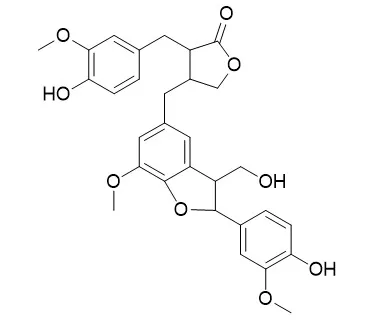| Description: |
Lappaol A has antioxidant and antiaging properties, it may promote the C. elegans longevity and stress resistance through a JNK-1-DAF-16 cascade. Lappaol A also has potential chemosensitizing activity, it may be candidates for developing novel adjuvant anticancer agents. |
| Targets: |
JNK | P-gp |
| In vitro: |
| Phytomedicine. 2015 Feb 15;22(2):301-7. | | Natural lignans from Arctium lappa modulate P-glycoprotein efflux function in multidrug resistant cancer cells.[Pubmed: 25765837 ] | Arctium lappa is a well-known traditional medicinal plant in China (TCM) and Europe that has been used for thousands of years to treat arthritis, baldness or cancer. The plant produces lignans as secondary metabolites which have a wide range of bioactivities. Yet, their ability to reverse multidrug resistance (MDR) in cancer cells has not been explored.
METHODS AND RESULTS:
In this study, we isolated six lignans from A. lappa seeds, namely arctigenin, matairesinol, arctiin, (iso)Lappaol A, lappaol C, and lappaol F. The MDR reversal potential of the isolated lignans and the underlying mechanism of action were studied using two MDR cancer cell lines, CaCo2 and CEM/ADR 5000 which overexpress P-gp and other ABC transporters. In two-drug combinations of lignans with the cytotoxic doxorubicin, all lignans exhibited synergistic effects in CaCo2 cells and matairesinol, arctiin, lappaol C and lappaol F display synergistic activity in CEM/ADR 5000 cells. Additionally, in three-drug combinations of lignans with the saponin digitonin and doxorubicin MDR reversal activity was even stronger enhanced. The lignans can increase the retention of the P-gp substrate rhodamine 123 in CEM/ADR 5000 cells, indicating that lignans can inhibit the activity of P-gp.
CONCLUSIONS:
Our study provides a first insight into the potential chemosensitizing activity of a series of natural lignans, which might be candidates for developing novel adjuvant anticancer agents. |
|
| In vivo: |
| Phytochemistry. 2015 Sep;117:340-50. | | Natural lignans from Arctium lappa as antiaging agents in Caenorhabditis elegans.[Pubmed: 26141518] | Arctium lappa is a well-known traditional medicinal plant in China (TCM) and Europe that has been used for thousands of years to treat arthritis, baldness or cancer. The plant produces lignans as secondary metabolites, which have a wide range of bioactivities. Yet, their antiaging potential has not been explored.
METHODS AND RESULTS:
In this study, we isolated six lignans from A. lappa seeds, namely arctigenin, matairesinol, arctiin, (iso)Lappaol A, lappaol C, and lappaol F. The antioxidant and antiaging properties of the isolated lignans were studied using Caenorhabditis elegans as a relevant animal model. All lignans at concentrations of 10 and 100 μM significantly extended the mean life span of C. elegans. The strongest effect was observed with matairesinol, which at a concentration of 100 μM extended the life span of worms by 25%. Additionally, we observed that five lignans are strong free radical-scavengers in vitro and in vivo and all lignans can improve survival of C. elegans under oxidative stress. Furthermore, the lignans can induce the nuclear translocation of the transcription factor DAF-16 and up-regulate its expression, suggesting that a possible underlying mechanism of the observed longevity-promoting activity of lignans depends on DAF-16 mediated signaling pathway.
CONCLUSIONS:
All lignans up-regulated the expression of jnk-1, indicating that lignans may promote the C. elegans longevity and stress resistance through a JNK-1-DAF-16 cascade. Our study reports new antiaging activities of lignans, which might be candidates for developing antiaging agents. |
|






 Cell. 2018 Jan 11;172(1-2):249-261.e12. doi: 10.1016/j.cell.2017.12.019.IF=36.216(2019)
Cell. 2018 Jan 11;172(1-2):249-261.e12. doi: 10.1016/j.cell.2017.12.019.IF=36.216(2019) Cell Metab. 2020 Mar 3;31(3):534-548.e5. doi: 10.1016/j.cmet.2020.01.002.IF=22.415(2019)
Cell Metab. 2020 Mar 3;31(3):534-548.e5. doi: 10.1016/j.cmet.2020.01.002.IF=22.415(2019) Mol Cell. 2017 Nov 16;68(4):673-685.e6. doi: 10.1016/j.molcel.2017.10.022.IF=14.548(2019)
Mol Cell. 2017 Nov 16;68(4):673-685.e6. doi: 10.1016/j.molcel.2017.10.022.IF=14.548(2019)